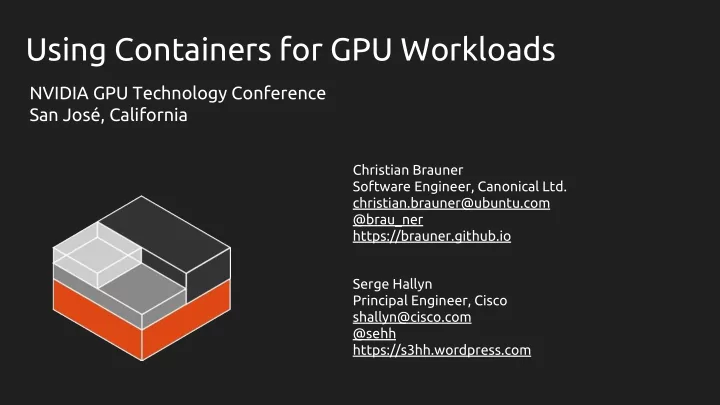

Using Containers for GPU Workloads NVIDIA GPU Technology Conference San José, California Christian Brauner Software Engineer, Canonical Ltd. christian.brauner@ubuntu.com @brau_ner https://brauner.github.io Serge Hallyn Principal Engineer, Cisco shallyn@cisco.com @sehh https://s3hh.wordpress.com
Who we are LXC ● Venerable container manager ● Umbrella project ○ Make containers better ○ Contributions to ■ Kernel ■ Other projects (shadow, glibc, …) ○ Create, foster new software projects ■ Lxcfs ■ lxd ■ pylxd ■ cgmanager ■ libresource
Containers: A userspace fiction Early uses of ‘containers’ (before containers): Newer uses of containers features: ● Jails ● NOVA network (openstack) ● VPS ● Sandstorm (sandbox) ● Plan 9 ● Chrome (sandbox) ● MLS (/tmp polyinstantiation) ● FTP daemons ● Checkpoint/restart ● Actual containers (lxc, lxd, docker, …) ● Borg
Building blocks ● Namespaces Advantages: ○ Mounts ● No emulated hardware ○ PID ○ UTS ● No guest kernel ○ IPC ● Flexible sharing with host ○ Cgroup ● Easy introspection/debugging from host ○ Network ○ User ○ (time, ima, LSM, …) ● Capabilities bounding set ● LSM ● Cgroups ● Seccomp ● Devpts
LXC and LXD
LXC vs LXD LXC LXD ● No long-running daemon ● Privileged long-running daemon ● Completely unprivileged use ● Image based ● Local use only ● Remote based ○ Macbook client: ● (lxcpath, container) lxc remote add host2 host2.example.org lxc launch ubuntu:xenial host2:i1 lxc exec host2:i1 touch /tag lxc publish host2:i1 host3: --alias img2
User namespace Requirements: Details: ● Uid separation (c1.1000 != c2.1000) ● Userids are mapped ● Container root privileged over container ● Capabilities targeted to user ns ● Container root not privileged over host ● Namespaces, resources owned by a ns ● Able to nest ● Hardware belongs to initial user ns ● Uid 1000 can always map uid 1000 ● Root can delegate other uids to 1000 ● (demonstrate)
Using Devices In Containers ● Very fast networking Infiniband, SR-IOV ● Interacting with devices cell phones, scientific equipment ● Dedicated block storage physical disks or partitions ● Computation GPUs
Using Devices In Containers ● Device access is handled by the host kernel The hardware doesn't need any special capabilities. ● Device nodes are identified and passed to the container The workload doesn't need to be container-aware. ● Devices can be shared very efficiently The same device can be passed to multiple containers, allowing for simultaneous access if the kernel driver supports this. ● Devices can be attached and detached on the fly They are just files or kernel constructs so can be moved around, added and removed as needed without requiring a reboot of the host or container.
Demo Time
Recommend
More recommend